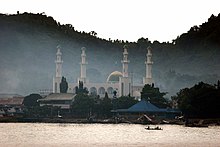Jolo, Sulu
The Seat of the Royal Sultanate of Sulu was in Astana Putih, which is Tausug for ‘White Palace’ in Umbul Duwa in the municipality of Indanan on Jolo Island, later on, the capital was moved in Maimbung during the 1800s.
The Sultanate was unable to bring agriculture to its full potential because the area was prone to erratic rainfall and drought.
Singapore served as a training ground from which they learned the Malay language and became experienced in dealing with Southeast Asians.
By 1875, Sultan Jamal ul-Azam wanted an English merchant to establish himself in order to break the monopoly at Jolo.
[11] The Spanish launched a surprise offensive under Colonel Juan Arolas in April 1887 by attacking the Sultanate's capital at Maimbung in an effort to crush resistance.
The traders in Singapore lost so heavily as a result that they refused to accept trade unless it was paid for in cash.
Along with the fear of increased taxation, many Chinese left to other parts of the Archipelago as Jolo lost its role as the regional entrepot.
Jolo is a volcanic island, which lies at the center of the Sulu Archipelago covering 890 square kilometres (340 sq mi).
There are numerous volcanoes and craters around Jolo with the last known activity (an earthquake assumed resulting from a submarine eruption from an undetermined location) taking place on September 21, 1897, causing devastating tsunamis in the archipelago and western Mindanao.
Jolo has a consistently very warm to hot, oppressively humid, and wet tropical rainforest climate (Köppen Af).
Other languages include Sama and Yakan, while Chavacano is also spoken by Christian and Muslim locals who maintain contacts and trade with the mainland Zamboanga Peninsula and Basilan.
About 99%[23] of the people living in Jolo practice Islam, but there is also a significant Christian minority consisting of Roman Catholics and Protestants.
Other missionaries included Rajah Baguinda and the Muslim Arabian scholar Sayid Abu Bakr, who became the first Sultan of Sulu.
Pangalay is a popular celebratory dance at Tausug weddings, which can last weeks depending on the financial status and agreement of the families.
Agricultural products include coconut, cassava, abaca, coffee, lanzones, jackfruit, durian, mangosteen and marang.
Economic development in Jolo has been hampered by instability, violence and unrest caused by the presence of several Islamist separatist groups in the Bangsamoro.
[36] Jolo is once the main stronghold for the Al-Qaeda-linked Abu Sayyaf terror group, and these conditions are ideal for militant recruitment.
However, the situation has improved especially after 2024 since the US contribution to the Operation Enduring Freedom – Philippines and involvement of foreign investors from other countries to improve social condition and developing the region's economy together with increased military operations and security from the Philippine authorities that greatly weaken the Abu Sayyaf and deplete their former source of income from criminal activities.
The United States Agency for International Development (USAID) has funded a ‘farm-to-market’ road between Maimbung and Jolo to help farmers transport agricultural produce to the market.
[44] In April 2008, the Jolo Zone of Peace, which was supported by the Geneva-based Centre for Humanitarian Dialogue (CHD), was established where firearms were restricted in mediating conflicts between clans.
On April 23, 2000, the Abu Sayyaf raided the Malaysian resort island of Sipadan and kidnapped 21 tourists from Germany, France, Finland and South Africa and brought them back to Jolo, asking for $25 million in ransom money.
Sulu governor Benjamin Loong supported the US Special Forces projects “Operation Smiles” of providing medical care, and building roads and schools.
The US Special Forces and Governor Loong hopes that winning respect and alleviating poverty from the people will stop terrorist recruitment.
[46] Three months after the September 11 attacks, George W. Bush announced the US was opening a second front in the War on Terror in the Philippines.
The bombings led by an unknown bandit but not exactly group Abu Sayyaf were widely condemned by local people in Jolo.
[citation needed] On 24 August 2020, at around 12:00 pm, a bomb exploded in front of the Paradise Food Plaza in Barangay Walled City.
Philippine Red Cross Chief Richard Gordon said that a motorcycle loaded with an improvised explosive device exploded near a military truck.
Moros identify mostly with the majority Muslim nations of Indonesia and Malaysia because of their geographic proximity, and linguistic and cultural similarities.
In 1974, fighting broke out when the government troops stopped the Moro National Liberation Front (MNLF) from taking over the town.
[7] Currently, the Moro National Liberation Front is the ruling party of the Autonomous Region in Muslim Mindanao (ARMM).







